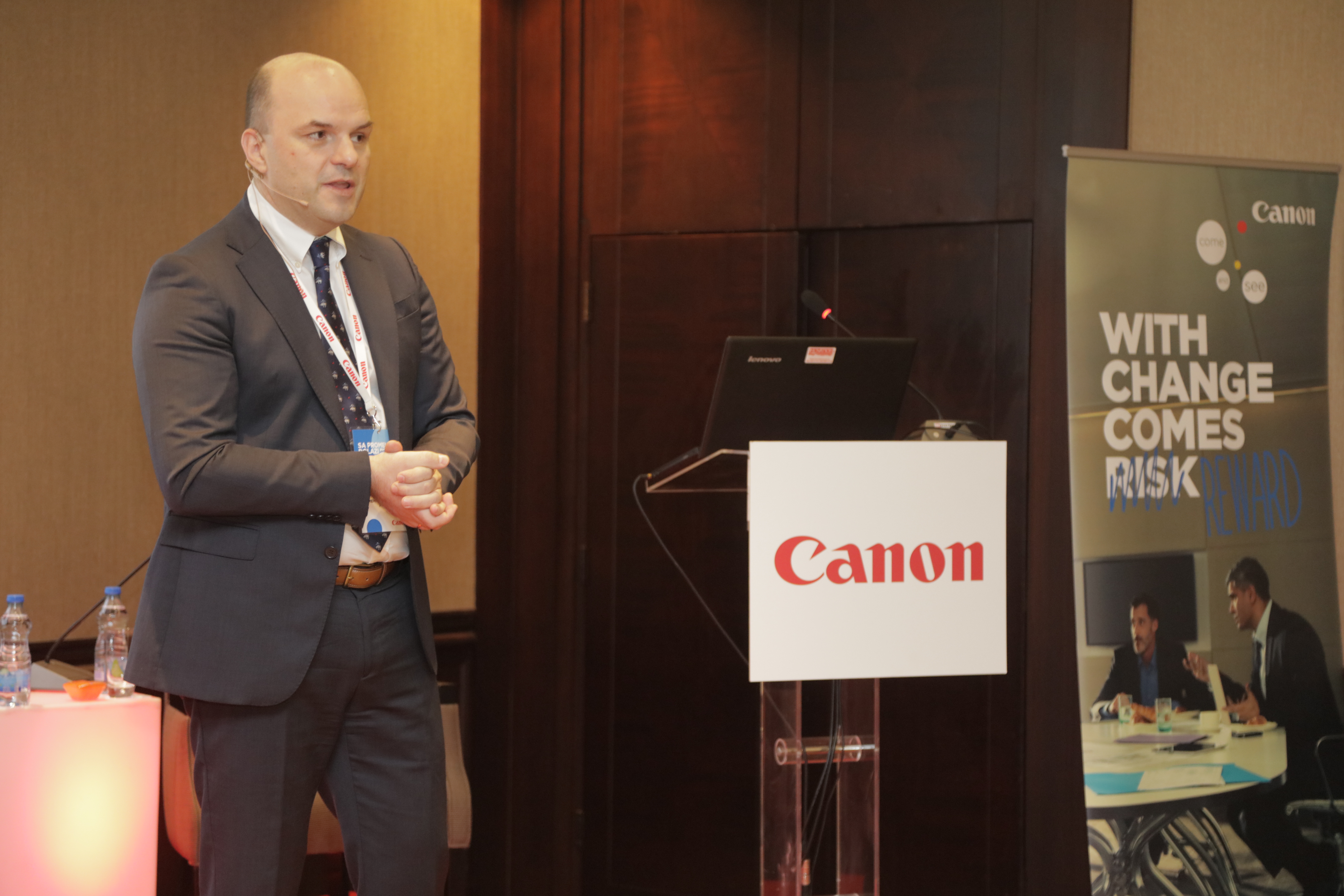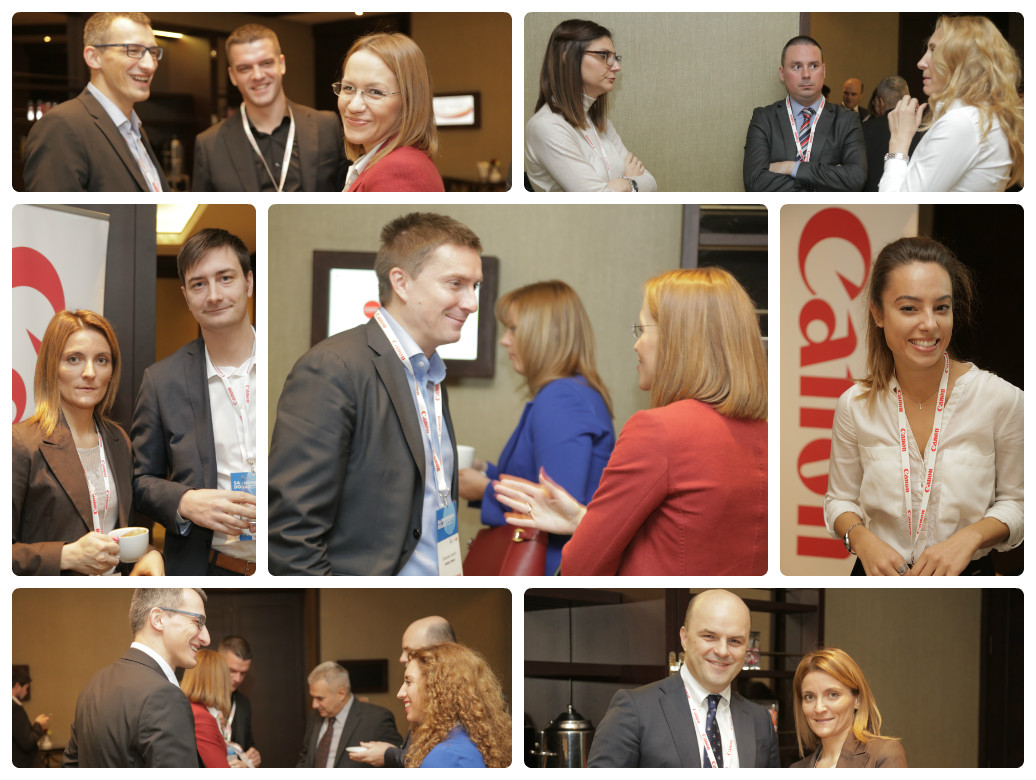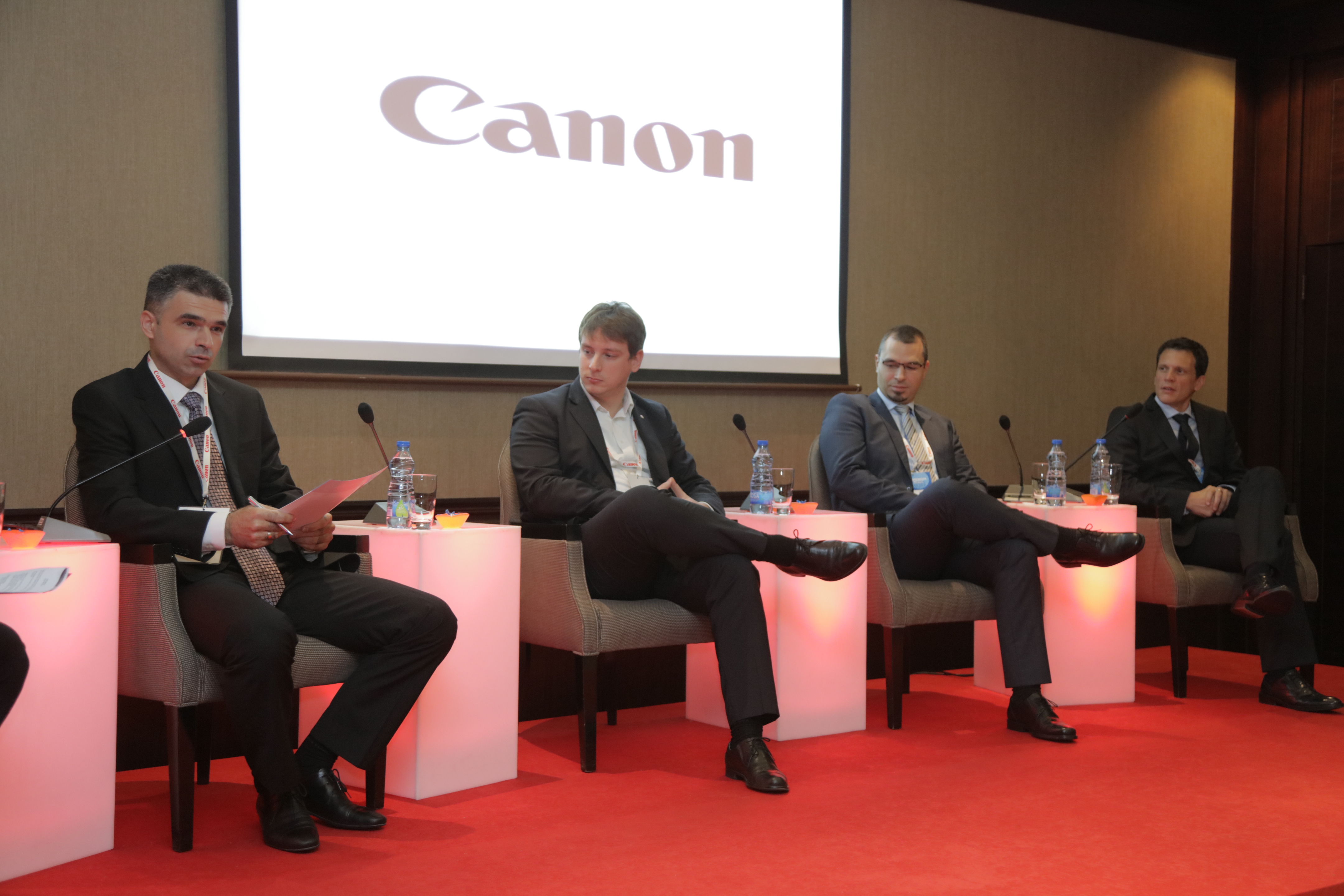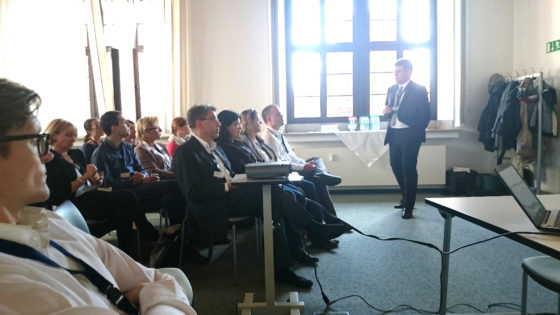The 24th ICV Serbia Meeting was held on November 18, 2015 in the beautiful ambience of the Hyatt Hotel. The meeting was organized in cooperation with the Canon and IDC companies, and was intended solely for CFOs. The meeting was attended by 30 participants. The aim was to discuss challenges that CFOs are facing nowadays and possible solutions.
The speakers at the meeting were:
- Bojan Šćepanović, Director, Management Centre Belgrade, and President of the ICV Serbia
- Nikola Pavlović, Business Development Manager, Canon Serbia
- Uroš Ćamilović, Partner, BDO Business Advisory
- Ademir Ćurtović, Business Development and Sales Manager MPS, Canon CEE, Canon Croatia
- Aleksander Bende, Product Business Development Canon Business Solution, Canon CEE GMBH
The first speaker was Bojan Šćepanović, on the topic “CFO as a Business Partner”.
Very inspirational, as always, Bojan dedicated his presentation to the changes that every CFO should keep pace with. The changes affected most the following areas:
- Environment
- IT
- Processes
Although we all look to the future, we often look back to sometime in the past, so the phrase “Back in my time…” is not unusual. That is how Bojan got us back in the time of the past by making a then-and-now parallel for each of these changes.
Explaining the changes in the environment, he touched sociological and economic changes. It is challenging and incomprehensible to many people, but these changes are integral parts of life of us all and the only thing we have left is to accept them. Tajči was our representative at the Eurovision contest in 1990s, but Conchita won the last year’s Eurosong. People used to walk their dogs in the park, and now they open Facebook accounts for their pets. Some of these changes are good, some of them we will condemn, but we cannot deny the fact that they are integral parts of our society.
IT is an area that is exposed to constant technological changes. It can be best explained using a simple example of buying and selling process. It used to be rather straightforward. You go to the green market and buy goods. Now the purchase is mostly made online. Letters used to be the main means of communication, and now Facebook, Viber, Messenger and Whatsapp took over primacy in everyday communication.
When it comes to processes, they underwent drastic changes as well. It used to be almost unimaginable to order a product from the US. Now it is a rather simple process. Not only ordering, but full customerisation. Products were not specially customised to consumers earlier. Now any customer can order e.g. sports shoes specially designed for him/her, and can do so somewhere from the US. In addition, corporate organisational chart was very simple earlier, while now there are drastic changes there as well.
Bojan called all these changes RE-CANONISATION! Considering that Canon keeps pace with the trends and constantly works on improving its solutions, this was a nice association for the whole story of changes. And where is CFO there? What would a CFO of the future be like? To summarise, three key things that a CFO of the future should have are:
- Strategic orientation. A new CFO must know business, products, and sales channels.
- IT orientation. A new CFO must be familiar with IT technology and keep pace with changes.
- Focus on process optimisation. CFO should be ruthless in optimising processes.
The next speaker was Nikola Pavlović. Nikola talked about the position of CFO in a modern company. A modern CFO must accept changes and also know what it is that the market needs. In addition, it is necessary for all in this process to speak the same language and to perfectly understand each other.
Canon offers different printing-related products and what is interesting to CFOs is the possibility of managing this system. In order for Canon to take part in these changes, it spent a lot of time on surveys and interviews of its users. Three Business Insight surveys played a big role in this. The first survey was conducted in 2013 covering around 1.700 users. Interviews were conducted with all of them, with decision-makers as well as with service users. The survey findings were that document management was very important, as well as the value of printing and material security and safety of data.
Based on the second survey, it was concluded that the print-run need decreases, while in the third survey the decision-makers said that they did not know how much a printed paper cost them.
The latest Business Insight is made for 2016. Companies of all sizes and industries took part, 25% of them being business service and finance companies. All functions and sectors were asked questions, and 64% of the respondents take part in decision-making. Some of the questions were:
- Why do you print in colour?
- Is the company familiarised with the MPS solution?
- What percentage of documents is digitised?
- How much do you know about printing costs?
48% of decision-makers have no idea about what the costs of printing are, while 62% of the users do not know this information. 78% of companies do not have the Managed Print System (MPS) and do not manage these costs.
The next speaker was Uroš Ćamilović. The topic of his presentation was cost optimisation that is the way to efficient business.
The aim of cost optimisation is:
- Improvement of business efficiency
- Increase in profitability
- Achievement of positive cash flows and
- Creation of the basis for future business growth.
Uroš also made a parallel between cost optimisation and cost reduction. When we want to reduce costs, we often do not think of the long-term consequences, and companies simply cut costs. Optimisation, on the other hand, is a more complex process, but it has positive effects on the short-term and long-term prospects for business growth. Some of the areas for optimisation that he mentioned certainly are print management, which is an excellent example of savings, as well as the possibility of outsourcing. There are many benefits. Some of them include solving financial problems, better business results, more competitive position and added value to capital owners.
After the three presentations, the guests had the opportunity to take a coffee break and socialise and, of course, continue talking about MPS solutions and cost optimisations.
After the break, Ademir Ćurtović gave his presentation. In his presentation, he talked in more detail about MPS solutions.
If we want to reduce costs, we have to know how much we spend. However, many costs are invisible. Ademir gave a nice comparison with an iceberg. Little is seen above the water surface. But invisible costs are many. Companies spend 10,800 euros per year on printing.
Here are some more interesting pieces of information:
- Companies have 10% more devices than they really need.
- It takes 25 hours to re-create a lost document
- Employees spend 40% of time by searching for a lost document
Such challenges are eliminated by implementing an MPS solution. The implementation process takes place in five steps:
- Taking a snapshot
- Designing a solution
- Implementation
- Monitoring
- Review
The implementation of an MPS solution achieves multiple benefits such as:
- Increased productivity
- Document safety
- Environmental protection
- More efficient management
The last presentation was held by Aleksander Bende. Aleksander works on the development of products for process improvement. According to his words, a CFO should know what is happening in the environment and how to achieve the best results with new technology. Modern IT tools in all areas may be used for business optimisation. Some of the frequent challenges are: how to interconnect information, how to protect document ownership, how to communicate information and how to monitor information. All of this can be done with Canon.
Special attention is paid to the following processes:
- P2P process
- Invoice processing
- Cost impact
The key question that arises is how to connect purchase to payment. There is a solution that monitors this process automatically and thus helps in cash flow management. With this solution, the whole process from purchase to payment develops 50% faster. Everything that is quickly completed leaves us time to do some other activities. All the time, you have insight into what is happening through different reports and dashboards. The control is full, you know what the costs are, and the documents are totally safe.
After Aleksander, a panel discussion followed. The moderator of the discussion was Bojan Šćepanović, and the participants were:
- Dragan Vještica, Head of Controlling, Metro Cash & Carry
- Ivan Tadić, Controlling Director, Hemofarm
- Uroš Ćamilović, Partner, BDO Business Advisory
- Aleksander Bende, Product Business Development Canon Business Solution, Canon CEE GMBH
Bojan asked the participants the questions relating to:
- Changes
- IT and
- Processes
We single out just a few of them here. The answers to the question “How do you look at changes in finance?” were very interesting. According to Dragan, the Finance used to be a department that records things, while now no decision is made without the Controlling and Finance Departments. Ivan Tadić thinks that CFO as a partner is the biggest change. Earlier, CFO was, in fact, an accountant and was engaged in “counting the dead”. Now he is oriented towards the future.
Uroš responded to the question “What do CFOs mostly look for?” by saying that the role of CFOs in recent years had been directed to improving the process and increasing the efficiency.
Aleksander responded to one of his questions by saying that CFO was transforming into technologies, which Canon noticed. So it would be best for CFO to develop into Chief Financial Technical Officer (CFTO); it will be the position of the future.
We also had a small prize contest during the discussion, where the guests had the task to guess how much a printed piece of paper costs.
The answers were very different and interesting, and so was the continuation of discussion. The socialising continued at lunch in the pleasant ambience of the Hyatt Hotel.
This was the 24th ICV Serbia Meeting. The RE-CANONISATION is under way; the question is just whether we recognise it and whether we can keep pace with it.






